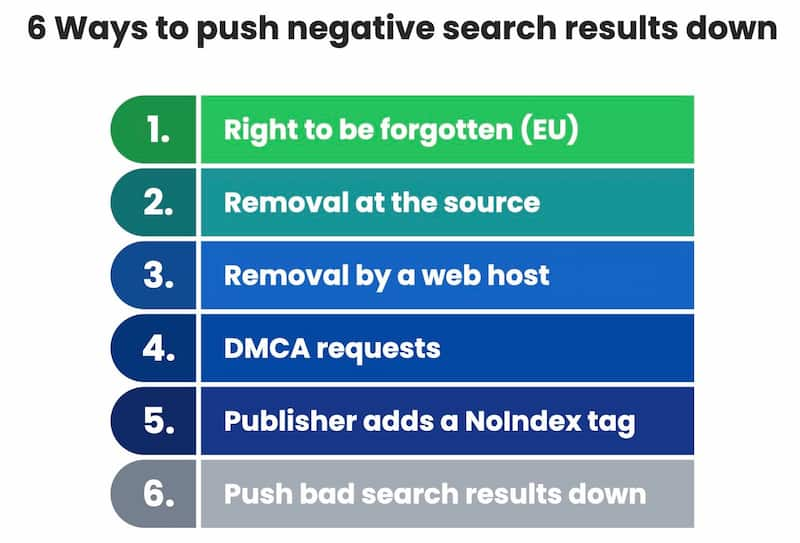How to Push Negative Search Results Down in SERPs
In reputation management, you can repair an online reputation by deleting online content, de-indexing it from search engines, or pushing it down in search results where it is seldom seen. The second approach is called “suppression”. This article details how to push down negative search results.
Removing, Deindexing, or Burying Negative Search Results
If online content is negative, untrue, or unflattering, the problem becomes a potentially reputationally damaging issue. These negative results can lead to a reduction of opportunities for both businesses and individuals. This article will outline the basics of pushing down negative search results fast so you can look better when someone Googles you.
It is critical that these damaging or even embarrassing negative search results are removed, de-indexed, or buried as soon as possible to avoid further damage or entrenchment.
Here are some of the most common ways to push down negative search results.
How to Push Negative Search Results Down
- Right To Be Forgotten (Not available in the United States)
- Removal at the source
- Removal by a web host
- De-index from search results with DMCA or similar
- Publisher adds a NoIndex tag to the page header
- Push bad search results down
Understanding “Right To Be Forgotten”
Since 2006, citizens of the European Union, along with a select few other countries like Argentina, have been safeguarded by the legal provision known as the Right To Be Forgotten (RTBF). This law obligates Google to omit specific search results under designated circumstances. Within the EU, an individual applying for RTBF can expect the targeted results to be removed “without undue delay”, typically within a month’s time.
However, in the United States, the “Right To Be Forgotten” isn’t recognized as a means to expunge search results. While there have been legal endeavors to introduce a similar law in the U.S. (some even preceding the advent of the Internet), it remains unestablished due to concerns regarding potential infringement on constitutional free speech rights and issues surrounding censorship. Conversely, countries like China have explicitly stated that a Right To Be Forgotten is non-existent.
De-indexing or Removing Content from Google Search Results
Certain search results can be omitted or entirely erased from Google’s search index if one submits a removal request. Valid grounds for de-indexing might include the elimination of sensitive details like tax ID numbers, bank account credentials, credit card information, handwritten signatures, and explicit photos shared without the individual’s consent.
Google has streamlined its removal request process, prioritizing the deletion of Personally Identifiable Information (PII) more efficiently. This enhancement aligns with Google’s dedicated effort to combat “doxing”—a malicious act of publishing someone’s PII on the internet.
If you encounter misleading information or content that breaches Google’s Terms of Service, it’s possible to report or flag it. This option is viable for genuine breaches, which may encompass hate speech or content promoting violence. Google also acts on legal directives, such as those associated with the 1998 Digital Millennium Copyright Act. Apart from Google, one can also approach the respective hosting service providers to delete specific content, contingent on the host’s terms of service.
Whenever a removal appears feasible, we typically recommend our clients opt for that solution initially.
Removing Content at Its Origin
Eliminating or concealing content is achievable at the initial point of publication, provided the responsible party consents. Although the publisher or author has the ability to delete content from a webpage, the timeframe for this action remains uncertain.
Often, a formal letter or email appeal suffices, particularly with news platforms that prioritize accuracy and factual reporting. To reinforce your request, you can consider sending a letter to the author. Here are some free templates to have the content removed at the source. Nonetheless, such an approach should be undertaken carefully since, depending on the circumstances and the aims of the original author, it can make things worse.
This blog post details how to remove negative online content.
Strategies for Enhancing Digital Reputation
Digital Suppression Strategy
In the realm of online reputation management, a common method is the strategic suppression of undesired content. The basis of this strategy is not always about deleting or hiding unwanted content but rather outperforming it so it becomes less visible or even invisible.
This is achieved by crafting content that is not only relevant but also of superior quality. Over time, well-optimized, high-quality content rises in search engine rankings, effectively pushing down less desirable results.
Principles of Suppression:
-
Relevance: Content created should resonate with what searchers are looking for. It should also genuinely represent the subject or entity in question. We use the E.A.T method of content development to achieve this.
-
Quality over Quantity: It isn’t about producing more, but about producing better. Google’s algorithms favor content that is original, useful, and authoritative (Authority is part of E.A.T).
-
Consistent Effort: Like any good strategy, results aren’t immediate. Regular updates, ongoing content creation, and search engine optimization (SEO) efforts are essential.
Illustrative Suppression Scenarios
-
Elevating Positive Press: Let’s say a major financial firm has unfavorable articles from prominent news sources like the NY Times on the first page of search results. The suppression strategy would involve promoting positive press or content to move those unfavorable links down.
-
Mitigating Regulatory Appearances: For a business, having regulatory sites like SEC.gov appear prominently could be concerning. The goal would be to highlight other relevant and positive content about the company to reduce the prominence of such links.
-
Managing Personal Reputation: If an executive finds herself plagued by negative blog posts on the first page of search results, the strategy would involve pushing up positive and neutral content about her.
Starting a Suppression Campaign
If you’re faced with unfavorable online content, consider partnering with experts like Reputation X. Our approach begins with:
-
Initial Assessment: We delve deep into your specific situation, analyzing the feasibility of a suppression campaign.
-
Strategic Proposal: After our research, we craft a proposal detailing our strategy. This includes goals, timelines, and actionable steps.
-
Collaborative Review: We value your input. After presenting our plan, we’ll collaborate with you to refine it, ensuring your unique needs are met.
-
Campaign Execution: Once approved, our team embarks on the meticulous task of improving your online reputation.
Remember, today, more than ever, your online reputation is often the first impression you make. Ensuring it’s a positive one is crucial for personal and professional success.
Negative Search Results: FAQs
How do you push down negative content in search results?
Right To Be Forgotten (EU and other countries). Removal at the source. Removal by a web host. De-index from search results with DMCA, Terms of Service violation or similar. The publisher adds a NoIndex tag to the page header. Push bad search results down.
What is Right To Be Forgotten?
Right To Be Forgotten is a law that mandates Google to remove search results from their index under certain circumstances for citizens of the European Union and select other countries. It is not available to residents of the United States.
What types of negative content will Google remove?
Often referred to as Personally Identifiable Information (PII), Google will remove some tax ID numbers, bank account numbers, credit cards, signatures, and sexually explicit images uploaded without the subject’s consent. Google will also remove content that it considers in violation of its Terms of Service as well as laws such as the Digital Millennium Copyright Act.

